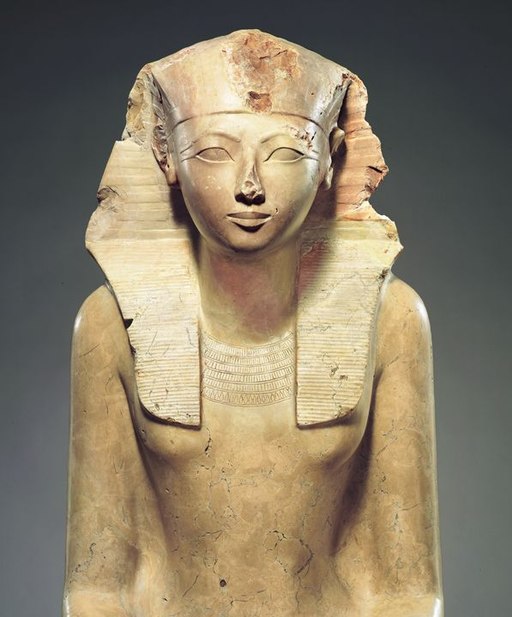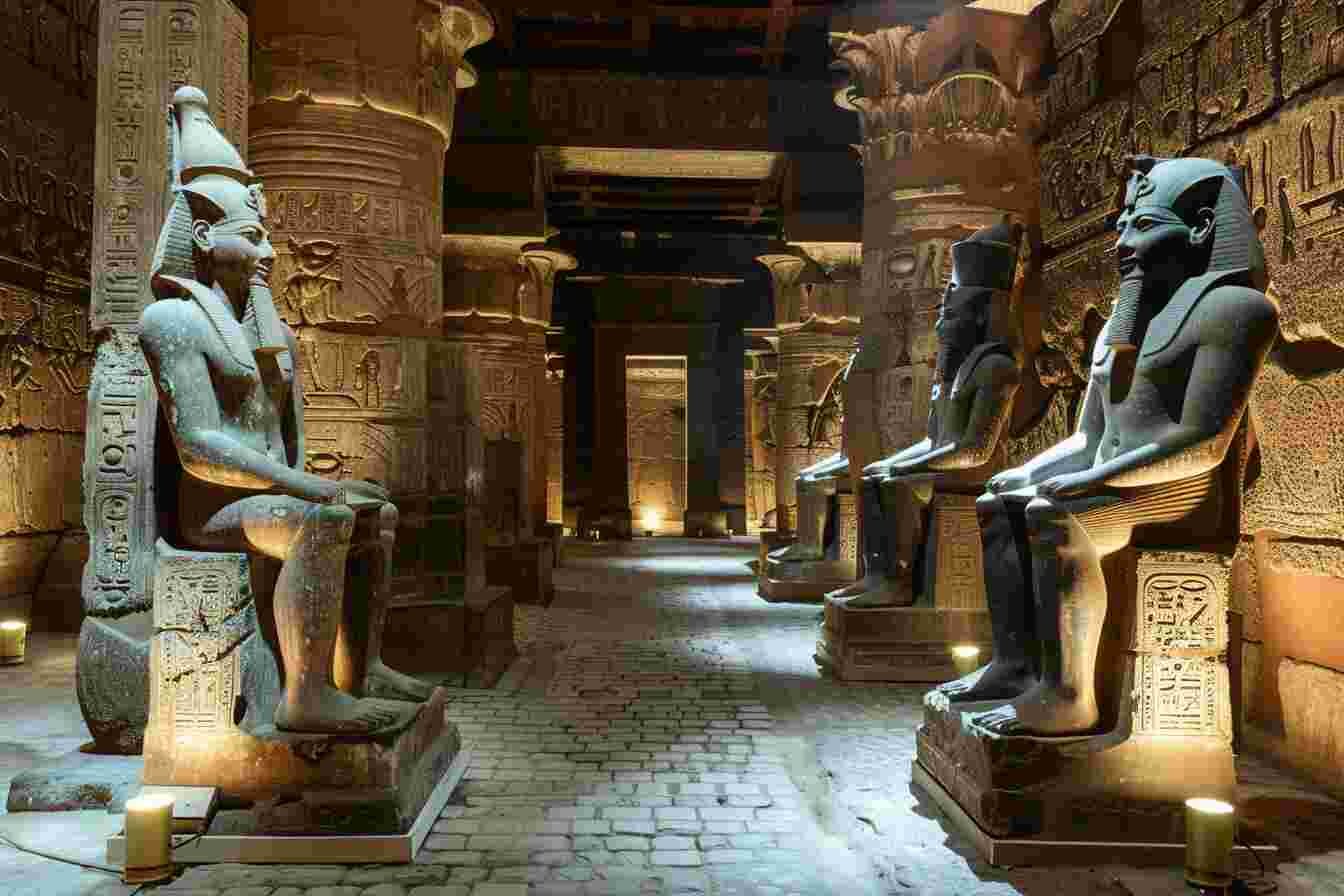Most Famous Pharaohs
Below are the most famous pharaohs. For over 3,000 years, many pharaohs ruled ancient Egypt. If it is impossible to draw up an exact list, it is estimated today that they were between 190 and 260 to succeed one another on the throne. Some have fallen into oblivion; others, men and women, have marked history with their names. Discover the greatest of them.
1. Cheops, who built the great pyramid of Giza.
2. Ramses II, a great conqueror.
3. Amenophis IV or Akhenaten, who tried to modify the Egyptian religion
4. Tutankhamun, whose tomb was discovered almost intact in 1922.
5. Cleopatra who, defeated by the Romans, committed suicide in 29 BC. AD and was the last pharaoh.
6. Hatshepsut is famous for her successful reign and ambitious building projects, notably the construction of her mortuary temple at Deir el-Bahari.
7. Seti I, renowned for his military campaigns, temple construction projects, and the exquisite reliefs and decorations in his mortuary temple, particularly the Abydos King List, which provides valuable information on the pharaohs of ancient Egypt.
8. Thutmose IV: Famous for his Dream Stele, which recounts his divine vision and legitimizes his claim to the throne, as well as his restoration and completion of the Great Sphinx of Giza, which had been buried in sand for centuries.
9. Ramses III, known for his military victories against invading forces, including the Sea Peoples, and his efforts to maintain stability and security during his reign, as depicted in the inscriptions at his mortuary temple in Medinet Habu.
The pharaoh holds the hook and the whip, insignia of royal power. He also has the ankh which is a kind of cross which symbolizes immortality. From his chin hangs the straight false beard, characteristic of kings, which differs from the curved beard of the gods. He has a headdress: the nemes. On the nemes there is the protective cobra (Uraeus) and the protective vulture.
Cheops (Khufu) and Ramses II (Ramesses the Great), the two greatest pharaohs of ancient Egypt
Khufu would have reigned between 2551 and 2526 BC He was especially famous for the architectural achievements he carried out. We owe him in particular the construction of the great pyramid of Giza, the only Wonder of the ancient world to have survived the centuries.
Cheops (Khufu) and Ramses II (Ramses the Great) are indeed considered among the most prominent and influential pharaohs in ancient Egyptian history, albeit from different eras.
Khufu, who reigned during the Old Kingdom’s Fourth Dynasty around 2589–2566 BC, is renowned primarily for commissioning the Great Pyramid of Giza, one of the Seven Wonders of the Ancient World. His reign marked an era of massive pyramid building, indicating the height of Egyptian architectural achievements and centralized royal authority.

Statuette of the sitting king Cheops of the 4th ancient Egyptian dynasty (height: 7.5 cm, width: 2.5 cm, depth: 2.9 cm), found 1903 in Abydos, exhibited at the Egyptian Museum in Cairo, Egypt. Olaf Tausch, CC BY 3.0, via Wikimedia Commons
Read also: Most Famous Paintings in the World
Ramses II
Ramses II ruled Egypt from 1279 to 1213 BC Known for having defeated the Hittites, he is often considered the pharaoh opposed to Moses. However, no historical evidence can attest to this!

Colossus statue of Ramses II standing between the columns of the Luxor Temple. Olaf Tausch, CC BY 3.0, via Wikimedia Commons
Ramses II, a pharaoh of the New Kingdom’s 19th Dynasty (1279–1213 BC), left an indelible mark on Egypt’s history. He was celebrated for his military prowess, ambitious building projects, and extensive diplomatic relationships. Ramses II expanded Egypt’s borders, engaged in numerous military campaigns, and built numerous temples and monuments, including the iconic Abu Simbel temples.
Both pharaohs achieved immense accomplishments that left a lasting legacy on Egypt. Khufu’s Great Pyramid stands as a testament to ancient engineering marvels, while Ramses II’s reign epitomizes Egypt’s military might and cultural renaissance. Their contributions to Egypt’s history and heritage solidify their places among the most significant and influential pharaohs of ancient Egypt.
Beyond his military achievements and building projects, Ramses II was a significant figure in ancient Egyptian religious and cultural life. He was associated with the restoration and construction of temples dedicated to various gods, and he played a central role in Egypt’s religious ceremonies and rituals.
Rosetta Stone | Without It, We Won’t Know About the Ancient Egypt
Amenophis IV or Akhenaten, who tried to modify the Egyptian religion
Known for his religious reforms, including the promotion of Aten, the sun god, as the supreme deity, and the establishment of a new capital city, Amarna, dedicated to the worship of Aten.
Amenhotep IV, later known as Akhenaten, is historically recognized for initiating a significant religious revolution in ancient Egypt during his reign from around 1353 to 1336 BC (approximately 3,370 to 3,353 years ago). He sought to radically transform Egypt’s traditional religious beliefs and practices.
Akhenaten introduced a revolutionary concept centered around the worship of a single deity, the Aten, symbolized by the sun’s disc. This religious shift moved away from the polytheistic beliefs of Egypt, where numerous gods and goddesses were venerated. The Aten was depicted as a sun disk with rays that ended in hands holding ankh symbols, signifying life.
Religious focus
To emphasize this new religious focus, Akhenaten moved the capital of Egypt from Thebes to a new city called Akhetaten (modern-day Amarna). He constructed temples dedicated to the Aten and abolished the worship of traditional gods, leading to a suppression of their cults.
Akhenaten’s religious reforms were accompanied by changes in artistic representations. The art of this period showed a departure from traditional styles, emphasizing naturalism, realism, and portraying the royal family in more intimate and humanistic ways.
However, Akhenaten’s religious revolution faced opposition and created turmoil within Egyptian society, disrupting established traditions and the powerful priesthood. After his death, his successors sought to erase his memory, attempting to restore the old religious practices and gods, leading to the removal of his name and monuments from historical records.
Despite the short-lived nature of Akhenaten’s religious reforms and their reversal after his death, his reign remains a fascinating period in ancient Egyptian history, showcasing an attempt to revolutionize religious beliefs and centralize worship around a single deity.

Akhenaten’s era, also known as the Amarna Period, occurred during the 18th Dynasty of ancient Egypt, approximately between 1353 and 1336 BC (approximately 3,370 to 3,353 years ago). He reigned as pharaoh during this time and initiated significant religious and artistic reforms, notably centered around the worship of the sun disc, Aten. Warren LeMay from Cincinnati, OH, United States, CC0, via Wikimedia Commons
Cleopatra VII, one of the greatest queens of ancient Egypt
Although she did not carry the title of pharaoh, Cleopatra VII had all the attributes. Ascended to the throne in 51 BC, she became a legendary queen of ancient Egypt. Renowned for her beauty, she is best known for her relationships with Julius Caesar and then Marc Antoine. By committing suicide in 30 BC, she only reinforced her legend.

Painting by Giovanni Battista Tiepolo, The Banquet of Cleopatra, 1743–44. Giovanni Battista Tiepolo, Public domain, via Wikimedia Commons
Cleopatra VII renowned for her political acumen, intelligence, and romantic liaisons, particularly her relationships with Julius Caesar and Mark Antony, which played significant roles in the politics of the Roman Republic.

Cleopatra, Queen-Pharaoh of Egypt. Bust of Cleopatra VII known as Cleopatra (Altes Museum, Berlin), the most likely portrait of the queen. © José Luiz Bernardes Ribeiro (CC BY-SA 4.0)
Cleopatra VII remains one of the most iconic and influential figures in ancient history, celebrated for her intelligence, charm, and political prowess as the last active ruler of the Ptolemaic Kingdom of Egypt.
Born in 69 BC, Cleopatra ascended to the throne at a young age, inheriting a kingdom in turmoil. Known for her exceptional intellect and linguistic abilities, she spoke multiple languages fluently, which helped her establish diplomatic relationships with influential figures of her time.
Cleopatra VII legend
Cleopatra’s reign was marked by political intrigue, alliances, and conflicts. She famously aligned herself with powerful Roman leaders, first Julius Caesar and later Mark Antony, forging crucial alliances that aimed to safeguard Egypt’s sovereignty.
Her legendary relationship with Mark Antony captured the imagination of historians and artists throughout the ages. Together, they faced opposition from Octavian (later Emperor Augustus) in the Roman Civil Wars. Their defeat at the Battle of Actium in 31 BC led to their demise, with Cleopatra choosing suicide over capture by Octavian’s forces.
Cleopatra’s legacy extends beyond her political prowess. She was a patron of the arts and sciences, known for her support of scholars and her efforts to preserve Egypt’s cultural heritage.
Her life and reign have been romanticized in literature, art, and film, perpetuating the image of Cleopatra as a brilliant and enigmatic ruler. Her story continues to fascinate, showcasing her as a symbol of female power, intellect, and resilience in the face of political upheaval.
King Tutankhamun and his treasure
Tutankhamun is one of the most famous pharaohs of ancient Egypt. However, his fame is mainly due to the treasure that concealed his burial. Arrived on the throne at the age of nine, he would have reigned only for ten years.
Tutankhamun’s treasure refers to the incredible collection of artifacts and riches found within the tomb of the ancient Egyptian pharaoh Tutankhamun (King Tut). Discovered by archaeologist Howard Carter in 1922 in the Valley of the Kings, this tomb held an astonishing array of items meant to accompany the young pharaoh into the afterlife.
The treasure trove contained a multitude of items, including intricately crafted golden artifacts, jewelry, furniture, chariots, weapons, and personal belongings. Among the most famous discoveries were King Tut’s golden funerary mask, adorned with precious stones, as well as his elaborate sarcophagi and ceremonial robes.
The meticulous craftsmanship and wealth of the items found in Tutankhamun’s tomb reflected the opulence and advanced artistic skills of ancient Egyptian civilization. The discovery of this tomb provided invaluable insights into ancient Egyptian burial practices, religious beliefs, and royal customs.
Tutankhamun’s treasure remains one of the most significant archaeological discoveries, captivating the world with its beauty, historical significance, and the mysteries it continues to unveil about ancient Egypt and its royalty.

Replica of the second sacophagus from the tomb of Tutankhamun. Jl FilpoC, CC BY-SA 4.0, via Wikimedia Commons
Hatshepsut
One of the few female pharaohs, Hatshepsut is famous for her successful reign and ambitious building projects, notably the construction of her mortuary temple at Deir el-Bahari.

Statue of Hatshepsut on display at the Metropolitan Museum of Art, New York City. Metropolitan Museum of Art, CC0, via Wikimedia Commons
Hatshepsut, a remarkable figure in ancient Egyptian history, was known for being one of the few women to rule as a pharaoh in her own right. During her reign from 1479 BC to 1458 BC, she initially served as regent for her young stepson, Thutmose III, before assuming full pharaonic power. Her almost 22-year rule, a relatively long reign for the time, was marked by peace and prosperity, with a focus on trade and diplomacy.
She commissioned ambitious building projects, including the impressive mortuary temple at Deir el-Bahri, and launched trading expeditions to Punt (present-day Somalia), bringing back valuable resources.

Mortuary temple of Hatshepsut
Djeser-Djeseru. Ian Lloyd, CC BY-SA 3.0, via Wikimedia Commons
Hatshepsut promoted herself as a powerful ruler by adopting traditional male pharaonic attire and titles. Considered one of the most successful pharaohs in Egyptian history, her reign marked a golden age of peace and prosperity, serving as inspiration for future female rulers. She was the daughter of King Thutmose I and Queen Ahmose and married her half-brother Thutmose II, later becoming regent for their stepson. Despite attempts by later rulers to erase her accomplishments from history, her tomb has survived, offering valuable insights into her reign.
Seti I
Renowned for his military campaigns, temple construction projects, and the exquisite reliefs and decorations in his mortuary temple, particularly the Abydos King List, which provides valuable information on the pharaohs of ancient Egypt.

Image of Seti I from his temple in Abydos, in Upper Egypt. Built around. 1300 BCE. Messuy at French Wikipedia, CC BY-SA 3.0, via Wikimedia Commons
Seti I, also known Sety I, was a pharaoh of ancient Egypt who ruled during the 19th Dynasty of the New Kingdom period. He reigned from around 1290 to 1279 BC, succeeding his father, Ramesses I. Seti I is renowned for his military campaigns, temple construction projects, and the exquisite reliefs and decorations in his mortuary temple at Abydos. He is also famous for commissioning the Abydos King List, a hieroglyphic inscription that lists the names of previous pharaohs, providing valuable historical information about ancient Egypt. Seti I was succeeded by his son, Ramesses II, who went on to become one of ancient Egypt’s most celebrated pharaohs.
Thutmose IV
Famous for his Dream Stele, which recounts his divine vision and legitimizes his claim to the throne, as well as his restoration and completion of the Great Sphinx of Giza, which had been buried in sand for centuries.

The regal visage of Thutmose IV, adorned with the illustrious blue crown, stands as a testament to the grandeur of the 18th Dynasty. This remarkable artifact, housed in the State Museum of Egyptian Art in Munich, offers a captivating glimpse into the opulent legacy of ancient Egyptian royalty. Osama Shukir Muhammed Amin FRCP(Glasg), CC BY-SA 4.0, via Wikimedia Commons
Thutmose IV, also known as Thutmosis IV or Tuthmosis IV, was a pharaoh of ancient Egypt who ruled during the 18th Dynasty of the New Kingdom period. He reigned from around 1401 to 1391 BC, succeeding his father, Amenhotep II. Thutmose IV is renowned for his Dream Stele, an inscribed monument erected between the paws of the Great Sphinx of Giza. The Dream Stele recounts Thutmose IV’s divine vision in which the Sphinx promised him kingship if he cleared the sand from its body. This event legitimized Thutmose IV’s claim to the throne and is considered one of the most significant events of his reign. Thutmose IV also restored and completed the Great Sphinx, which had been buried in sand for centuries, further solidifying his legacy as a capable and revered pharaoh of ancient Egypt.
Ramses III
Known for his military victories against invading forces, including the Sea Peoples, and his efforts to maintain stability and security during his reign, as depicted in the inscriptions at his mortuary temple in Medinet Habu.

The intricately carved relief from the sanctuary of the Temple of Khonsu at Karnak, nestled near the majestic city of Luxor, Egypt, offers a mesmerizing portrayal of the revered pharaoh, Ramesses III. This magnificent artwork captures the essence of his illustrious reign, showcasing his divine authority and prowess as a leader. As one gazes upon this masterpiece, they are transported back in time to an era of opulence and grandeur, where the legacy of Ramesses III continues to inspire awe and admiration. Asavaa, CC BY-SA 3.0, via Wikimedia Commons
Ramses III was a pharaoh of ancient Egypt who ruled during the 20th Dynasty of the New Kingdom period. He reigned from around 1186 to 1155 BC, succeeding his father, Setnakhte. Ramses III is renowned for his military victories against invading forces, including the Sea Peoples, who threatened Egypt’s security during his reign. He is also celebrated for his extensive building projects, including the construction of his mortuary temple at Medinet Habu, which contains detailed reliefs depicting his military campaigns and divine rituals. Despite facing internal unrest and economic challenges later in his reign, Ramses III is remembered as a capable ruler who successfully defended Egypt from external threats and maintained stability and prosperity throughout much of his reign.
Egypt Dynasty | Timeline, List of Egyptian Ancient dynasties and Pharaohs
Sources: PinterPandai, Britannica, History
Photo powered by Midjourney
Rosetta Stone | Without It, We Won’t Know About the Ancient Egypt



